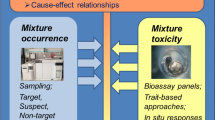Abstract
The key findings to emerge from the successful Direct Toxicity Assessment Demonstration Programme are reviewed. At present, whole sample toxicity tests can identify and help control releases of complex mixtures that are likely to cause short-term toxic effects. Protection of aquatic organisms from the many hazardous chemicals that enter the environment, usually as complex mixtures, will require the introduction of new and improved techniques that are affordable and provide rapid turnaround of information. A number of bioassays were rigorously tested during the DTA programme. Further developments are suggested and other methods, including biosensors, biomarkers, and biological survey are briefly reviewed.
Similar content being viewed by others
References
Chambers, J.E., Boone, J.S., Carr, R.L., Chambers, H.W. and Straus, D.L. (2002). Biomarkers as predictors in health and ecological risk assessment. Human Ecol. Risk Assessment 8(1), 165–76.
Commission of the European Communities (2001). White paper on a strategy for a future chemicals policy. Brussels COM(2001) 88 final.
Crane, M., Delaney, P., Parker, P., Walker, C. and Watson, S. (1995). The effect of Malathion 60 on Gammarus pulex (L) below watercress beds. Environ. Toxicol. Chem. 14, 1181–88.
Crane, M., Johnson, I. and Maltby, L. (1996). In-situ assays for monitoring the toxic impacts of waste in rivers. In J.F. Tapp, S.M. Hunt and J.R. Wharfe (eds). Toxic Impacts of Wastes on the Aquatic Environment. UK: R oyal Society of Chemistry.
Crane, M., Grosso, A., Whitehouse, P. and Forrow, D. (2004). Risk characterisation in Direct Toxicity Assessment of the River Esk and the Tees Estuary. Ecotoxicology 13, 463–74.
DETR (now DEFRA). (1999). Sustainable Production and Use of Chemicals-December 1999. ISBN 1-85-112333-4.
Depledge, M.H. (1993). The rational basis for the use of biomarkers as ecotoxicological tools. In M.C. Fossi and C. Leonzio (eds). Nondestructive Biomarkers in Vertebrates. Boca Raton: Lewis Publishers.
De Vlaming, D., Denton, D. and Crane, M. (2001). Multiple lines of evidence: Hall and Giddings. Human Ecol. Risk Assessment 7, 443–57.
Environment Agency (2001). Diagnosing and predicting river health from biological survey data using pattern recognition and plausible reasoning. R&D Report E1-056/TR2. ISBN 1-85-705816-X.
Environment Agency (2002a). Managing Chemicals for a Better Environment-The Environment Agency's Strategy. Consultation Document, Environment Agency for England and Wales.
Environment Agency (2002b). The Identification of oestrogenic effects in wild fish-Phase 2. R&D Technical Report W2-014/TR. ISBN 1-85705-670-1.
Girling, A.E., Riddle, A.M., Mitchell, G.M., Chown, P., Tinsley, D., Buckler, C., Johnson, I. and Benstead, R. (2004). Estimating spatial patterns of effluent exposure concentrations in Direct Toxicity Assessment studies. Ecotoxicology 13, 449–61.
Hutchings, M., Johnson, I., Hayes, E., Girling, A., Thain, J., Thomas, K., Benstead, R., Whale, G., Wordon, J., Maddox, R. and Chown, P. (2004). Toxicity Reduction Evaluation, Toxicity Identification Evaluation and Toxicity Tracking in Direct Toxicity Assessment. Ecotoxicology 13, 475–84.
Institute for Environmental Health (1996). The use of biomarkers in environmental exposure assessment. Medical Research Council Report R5. ISBN 1-89911007-0.
Jobling, S., Nolan, M., Tyler, C., Brighty, G. and Sumpter, J.P. (1998). Wide spread sexual disruption in wild fish. Environ. Sci. Technol. 32, 2498–506.
Johnson, I., Whitehouse, P., Hutchings, M., Benstead, R. and Thain, J. (2004). Bioassay selection, experimental design and quality control/assurance for use in effluent assessment and control. Ecotoxicology 13, 437–47.
Langston, W.J. (1995). Tributyl tin in the marine environment:A review of past and present risks. Pesticide Outlook 6, 18–24.
Maltby, L., Clayton, S.A., Wood, R.M. and McLoughlin, N. (2002). Evaluation of the Gammarus pulex in situ feeding assay as a biomonitor of water quality: Robustness, responsiveness, and reliance. Environ. Toxicol. Chem. 21, 361–68.
McCarty, L.S., Power, M. and Munkittrick, K.R. (2002). Bioindicators versus biomarkers in ecological risk assessment. Human Ecol. Risk Assessment 8(1), 159–64.
Minchin, A., Davies, I.M., Pymm, H. and Grewar, G.N. (1999). North Sea imposex survey; CW0825 August 1998-July 1999. Fisheries Research Services Report No 11/99.
National Rivers Authority (1995). Identification of screening, lethal and sublethal toxicity tests for assessing effluent toxicity. SNIFFER/NRA R&D Note 389, NR3930/7371.
OSPAR (2000). Background document concerning the elaboration of programmes and measures relating to whole effluent assessment OSPAR Commission, 2000. ISBN 0-946955-98-0.
Power, E.A. and Boumphrey, R. (2004). International trends in bioassay use for effluent management. Ecotoxicology 13, 377–98.
Roddie, B.D., Redshaw, C.J. and Nixon, S. (1996). Sublethal biological effects monitoring using the common mussel (Mytilus edulis): Comparison of laboratory and in-situ effects of an industrial effluent discharge. In J.F. Tapp, S.M. Hunt and J.R. Wharfe (eds). Toxic Impacts of Waste on the Aquatic Environment. UK: Royal Society of Chemistry.
Tinsley, D., Wharfe, J.R., Campbell, D., Chown, P., Taylor, D., Upton, J. and Taylor, C. (2004). The use of direct toxicity assessment in the assessment and control of complex effluents in the UK: A demonstration programme. Ecotoxicology 13, 423–36.
Wharfe, J.R. (2004). Hazardous chemicals in complex mixtures-a role for Direct Toxicity Assessment. Ecotoxicology 13, 413–21.
Author information
Authors and Affiliations
Rights and permissions
About this article
Cite this article
Wharfe, J., Tinsley, D. & Crane, M. Managing Complex Mixtures of Chemicals – A Forward Look From The Regulators’ Perspective. Ecotoxicology 13, 485–492 (2004). https://doi.org/10.1023/B:ECTX.0000035298.28258.50
Issue Date:
DOI: https://doi.org/10.1023/B:ECTX.0000035298.28258.50




